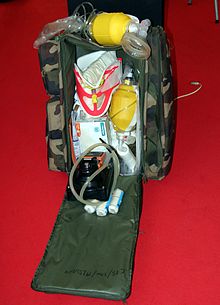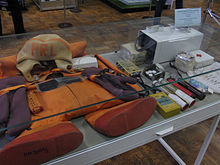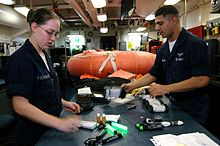- Survival kit
-
A survival kit is a package of basic tools and supplies prepared in advance as an aid to survival in an emergency. Military aircraft, lifeboats, and spacecraft are equipped with survival kits.
Survival kits, in a variety of sizes, contain supplies and tools to provide a person with basic shelter against the elements, help them keep warm, meet their health and first aid needs, provide food and water, signal to rescuers, and assist them in finding their way back to help. Supplies in a survival kit normally contain a knife (often a Swiss army knife or a multi-tool), matches, tinder, first aid kit, bandana, fish hooks, sewing kit, and an LED flashlight and laser pointer with long shelf-life batteries (usually lithium type).
Civilians such as forestry workers, surveyors, or bush pilots, who work in remote locations or in regions with extreme climate conditions may also be equipped with survival kits. Disaster supplies are also kept on hand by those who live in areas prone to earthquakes or other natural disasters. For the average citizen to practice disaster preparedness, some towns will have survival stores to keep survival supplies in stock.
Contents
General contents
Shelter or warmth
- Reflective "aluminized" (Mylar coated) space blanket or survival blanket to retain body heat (and signal)
- Lightweight poncho for protection against wind and rain
- "Tube tent" or bivvy bag
- Tarp with grommets or tie-tapes (best if nylon or polyester)
- Large plastic trash bag as poncho or expedient shelter roof
- Ferrocerium rod (AKA "Metal match", "Hot Spark", "Firesteel", "Magnesium fire starter") and fire striker for fire-starting, Fire piston or Solar Spark Lighter
- Waterproof matches or cigarette lighter
- Cotton balls or pads smeared with white petroleum for fire starting (can be carried in 35 mm container or heat-sealed inside large diameter plastic straw)
Health and first aid
First aid kit with:
- Bandages
- Band-aids
- Sterile combine dressing, and gauze pads
- Adhesive tape, and gauze tape
- Medical tweezers
- Surgical razor or scalpel
- Disinfectant pads
- Latex gloves (rubber if allergic to latex, to protect first aider against infection)
- A 30 day supply of personal prescription medication
- Antibiotic cream
- Epinephrine and antihistamines for allergic reactions, primarily to insect stings
- Rubbing alcohol
- suture kit or sterile disposable surgical stapler.
- Oxytetracycline tablets (for diarrhea or infection)
- Aspirin
- Extra pair of prescription eyeglasses or contacts
- Sunscreen (where appropriate, above 30 SPF)
- 100% UV protective sunglasses ("UV 400") (protects eyes from harmful UV radiation. Polarized glasses are not necessarily UV protective, but aid with glare only).
Food and water
- Water in sealed containers for dry areas, or water purification tablets in areas where water is available but may be contaminated.
- Heavy duty aluminum foil to create a distillation tube to remove salt from salt water during boiling/condensation. Must have another receptacle to collect condensate.
- Canned food, Ready-to-eat meals (MRE), or high-energy foods such as chocolate or emergency food bars.
- Fishing line and gear (fish hooks, lures, and split shot leads)
- Snare wire
- Gill Net (for emergency fishing)
Since the primary goal of a survival kit for lost or injured persons is rescue, this part of the kit is the most essential.
- Whistle.
- Signal mirror.
- High power LED light (able to have batteries replaced, and carry an extra battery), white lens, with signaling capabilities. Strobe versions are available for some lights. Use lithium cells only, due to superior shelf life.
- Flare: three fires in a triangle is the international distress signal
- laser pointer with lithium batteries, for superior signaling range. Laser pointers have resulted in at least one rescue: during the night in August 2010 two men and a boy were rescued from marshland after their red laser pen was spotted by rescue teams.[1]
- Surveyor's tape - orange or chartreuse for marking location for rescuers
- Pen/pencil and paper for leaving notes to rescuers about direction of travel
- Compass
- Trail maps/charts (if location is known in advance)
- Survival manual for technique reference
Multipurpose tools or materials
- Fixed-blade knife, or multitool knife such as Swiss Army knife or multitool
- Heavy-duty needle and thread for repairing clothing and equipment
- Red or orange plastic bag(s) or trash bags
- Sturdy cord or "550" parachute cord for setting up a tarpaulin and snaring small animals
- Hatchet with sheath for cold conditions, or machete for tropical conditions (shelter and fire)
- Candles for light, signaling, firestarting
- Metal "water bottle" for water storage, boiling, purification, cooking
Lifeboat survival kits
Lifeboat survival kits are stowed in inflatable or rigid lifeboats or life rafts; the contents of these kits are mandated by coast guard or maritime regulations. These kits provide basic survival tools and supplies to enable passengers to survive until they are rescued. In addition to relying on lifeboat survival kits, many mariners will assemble a "ditch bag" or "abandon ship bag" containing additional survival supplies. Lifeboat survival kit items typically include:
- Safety equipment
- Communications and navigation
- Compass
- Distress beacons (EPIRBs)
- Red flare, rocket parachute flare, and/or smoke signal flare
- laser pointer for signaling aircraft (red is color of distress, but green color is higher power and will be seen farther), with lithium cells, in double waterproof plastic pouch
- Radar reflector (to help rescuers locate the raft)
- Lantern and fuel, if fuel doubles as firestarter
- Radio transceiver, standard VHF marine and a optional amateur radio if a licensed radio amateur (see Ham Radio) or an AM/FM/Weather/Shortwave radio receiver
- GPS
- (lighter)
- Food and water
- Fishing kit
- Rainwater collection equipment
- Seawater desalination kit
- Water (typically 3 liters/person/day)
- Emergency high-calorie rations/food (not as important as water) Chocolate has superior calorie/weight ratio
- Other tools and boating items
- Hatchet and knife
- Waterproof flashlight
- Heaving line
- Ladder
- Sea anchor (also called a "sea drogue")
- Bailer
- Bilge pump
- Boat hook
- Bucket
- Any knife
Military kits
Survival kits for military aviators are often modified according to the environment of operations:
- In desert areas, survival kits may have more water and sunscreen, and have additional items such as shade hats, a compass, a whistle, medical equipment, tinder, matches, and sun glasses.
- In tropical areas, a survival kit may have mosquito head netting, additional insect repellent, anti-fungal cream, a machete, water purification tablets, foot powder, matches, a flint strike, a compass, a wire saw, a space blanket, medical equipment (gauze pads, elastic gauze bandage, antiseptic creams, anti-malaria tablets, anti-infection tablets, bandages, etc.), salt tablets, a fishing kit, snare wire, extra socks, a candle, a signal mirror, flares, a sewing kit, safety pins, tinder, tape, a whistle, and rations.
- In arctic or alpine areas, survival kits may have additional cold weather clothing (winter hats and gloves), sleeping bags, chemical "hand warmer" packets, sun glasses/snow goggles, snowshoes, a collapsible shovel, a snare wire for small animals, a frying pan, a camp stove, camp stove fuel, a space blanket, matches, a whistle, a compass, tinder, medical equipment, a flint strike, a wire saw, extra socks and a tent designed for arctic use.
- For personnel who are flying over large bodies of water, a survival kit may have additional items such as flotation vests, fishing nets, fishing equipment, fluorescent sea marking dye, a flare launching gun and cartridges (and perhaps a revolver and tracer ammunition), a survival radio (e.g., an AN/PRC-90), a distress marker light, seawater desalting kit, a raft repair kit, a paddle, a bailer and sponge, sunscreen, medical equipment, a whistle, a compass, and a sun shade hat.
The US Army uses several basic survival kits, mainly for aviators, which are stored in canvas carrying bags. Aviators in planes with ejection seats have survival kits in the seat pan and the survival vest (SRU-21P) worn by US helicopter crews also contains some basic survival items.
Mini survival kits
"Mini survival kits" or "Altoids tin" survival kits are small kits that contain a few basic survival tools. These kits often include a small compass, waterproof matches, a fishing hook and fishing line, a large plastic garbage bag, a small vial of bleach, a small candle, a jigsaw blade, an Exacto knife blade, and a safety pin. Pre-packaged survival kits may also include instructions in survival techniques, including fire-starting or first aid methods. In addition, parachute cord can be wrapped around the tin. The parachute cord can be used for setting up an emergency shelter or snaring small animals. They are designed to fit within a container roughly the size of a mint tin.
Vehicle kits
Another level in some preparedness plans are Vehicle Kits. In some cases, supplies and equipment may be loaded into vehicle such as a van or truck with bicycle racks and an extra “reserve” gas tank. Some survivalists also carry a small (e.g., 250 cc) off-road-capable motorcycle in the van or truck.
Food supplies in the bug-out vehicle include hundreds of pounds of wheat, rice, and beans, and enough honey, powdered milk, canned goods, bottled fruit, vitamins, dehydrated fruits and vegetables, salt, pepper, spices, and oil for several months. In addition, the kits often contain high-calorie energy bars, a cooking kit, utensils, liquid soap, and towels. The water supplies may include bottled water, filtering kit, bottles, collapsible water containers, and chlorine bleach for water purification. Food preparation and washing equipment may include items such as a grain grinder, a bread mixer, a strainer, a manual can opener, a steam canner with canning jars and O-rings, cutlery, knives, an electric 12-volt cooler icebox, kerosene lamps and heaters, kerosene or propane stoves, extra fuel, a clothes wringer, a foot-operated treadle sewing machine, and an electric hot plate (which would require an inverter to operate off a car battery).
The medical supplies may include a blood pressure gauge, stethoscope, scissors, tweezers, forceps, disposable scalpels, two thermometers (oral and rectal), inflatable splints, bandages, sutures, adhesive tape, gauze, burn ointment, antibiotic ointment, aspirin, rubbing alcohol, ipecac syrup, sterile water, cotton rags, soap, and cotton swabs.
The transportation items may include bicycles with off-road tires and suspension, emergency tools and spare auto parts (e.g., fuses, fan belts, light bulbs, head light, tire pump, etc.), and an inflatable raft with paddles.
In addition, the kits may contain typical individual “survival kit” items, such as nylon tarps, extra clothes and coats, blankets, sleeping bags, matches (and/or other fire starting equipment), a compass and maps, rechargeable flashlights, toilet paper, soap, a pocket knife and bowie knife, a fishing kit, a portable camping stove, a power inverter, backpack, paper and pencil, a signaling mirror, flashlight, whistle, cable saw, bleach, insect repellent, magnifying glass, rope and nylon cord, pulleys, and a pistol and ammunition.
The communications equipment may include a multi-band receiver/scanner, a citizens band (CB) radio, portable “walkie-talkies” with rechargeable batteries, and a portable battery-powered television. The power supplies may include a diesel or gasoline generator with a one month fuel supply, an auto battery and charger, extension cord, flashlights, rechargeable batteries (with recharger), an electric multi meter, and a test light. Defense items include a revolver, semi-automatic pistol, rifle, shotgun, ammunition, mace or pepper spray, and a large knife such as a KA-BAR or a bowie knife.
Tools may include cutting tools such as saws, axes and hatchets; mechanical advantage aids such as a pry bar or wrecking bar, ropes, pulleys, or a 'come-a-long" hand-operated winch; construction tools such as pliers, chisels, a hammer, screwdrivers, a hand-operated twist drill, vise grip pliers, glue, nails, nuts, bolts, and screws; mechanical repair tools such as an arc welder, an oxy-acetylene torch, a propane torch with a spark lighter, a solder iron and flux, wrench set, a nut driver, a tap and die set, a socket set, and a fire extinguisher. As well, some survivalists bring barterable items such as fishing line, liquid soap, insect repellent, light bulbs, can openers, extra fuels, motor oil, and ammunition.
Natural disasters
The US government's Homeland Security website provides a list of in-home emergency kit items.[2] The list focuses on the basics of survival: fresh water, food, clean air and materials to maintain body warmth. The recommended basic emergency kit items include:
- Water, at least one gallon of water per person for each day for drinking & sanitation (should be rotated every 3 months)
- Food, non-perishable food for at least three days which is not required to be cooked or refrigerated
- Emergency food bars, preferably the products with 2,400 or 3,600 calories and contain no coconut or tropical oils to which many people may have an allergic reaction, in addition to non-perishable food which does not require cooking or refrigeration
- Battery- and/or hand-powered radio with the Weather band
- Flashlight (battery- or hand-powered)
- Extra batteries for anything needing them
- First aid kit
- Copies of any medical prescriptions
- Whistle to signal
- Dust mask, plastic sheeting and duct tape to shelter-in-place
- Moist towelettes, garbage bags and plastic ties for personal sanitation
- Wrench or pliers to turn off water valves
- Can opener for canned food
- Local maps
- Spare keys for household & motor vehicles
- Sturdy, comfortable shoes & lightweight raingear
- Contact & meeting place information for the household
Earthquake
Below is list of commonly recommended items for an emergency earthquake kit:
- Food and water to last at least three to four days
- Water purification tablets/portable water filter
- Heavy-duty gloves
- A first aid kit
- A minimum of $100 in cash, at least half of which should be in small denominations
- Family photos and descriptions (to aid emergency personnel in finding missing people)
- Copies of personal identification and important papers such as insurance documents, driver's license, etc.
- A flashlight (LED type for greatest efficiency) and radio (battery-, solar-, and/or hand-powered)
- Extra batteries (lithium type for longest shelf life).
- Goggles and dust mask
- A personal commode with sanitary bags
- Water: one gallon per person, per day
Hurricane
For hurricanes, National Oceanic and Atmospheric Administration (NOAA) recommends that the 'disaster bag' include:[3]
- A flashlight with spare batteries and
- A battery operated portable radio (and spare batteries);
- A battery operated NOAA weather radio (and spare batteries);
- A "Self Powered Radio" and a "Self Powered Flashlight". One, "Eton" model has the Weather Band and it is "self powered". Some of these will keep your cell phone charged
- First aid kit and manual;
- Prescription medicines (be sure to refill them once they expire);
- Cash and a credit card;
- A cell phone with a fully charged spare battery;
- Spare keys;
- High energy non-perishable food;
- One warm blanket or sleeping bag per person;
- Special items for infant, elderly or disabled family members;
- Change of clothing.
Bug-out bags
The term "survival kit" may also refer to the larger, portable survival kits prepared by survivalists, called "bug-out bags" (BOBs), "Personal Emergency Relocation Kits" (PERKs) or "get out of Dodge" (GOOD) kits, which are packed into backpacks, or even duffel bags. These kits are designed specifically to be more easily carried by the individual in case alternate forms of transportation are unavailable or impossible to use.
These bags contain supplies such as food, water purification equipment, clothing, medical equipment, communications gear, and tools.
The Bug-out Bag is presented by many to be the first level of preparedness that anyone should put together, simply by virtue of its overall usefulness. As noted elsewhere, the man-portable kit can be used when you don't have to leave. It can be thrown into a vehicle when the situation allows you to drive away from the area. It also provides you with a kit that can be carried out of an affected area if the damage is too great, such as when found after a severe earthquake, to drive a vehicle over rubble or obstacles.
See also
- Bug-out bag
- Community Emergency Response Team
- Firearm (tool)
- Hiking equipment
- Mini survival kit
- Survival skills
- Survivalism
References
External links
Categories:- Survival skills
- Disaster preparedness
Wikimedia Foundation. 2010.



